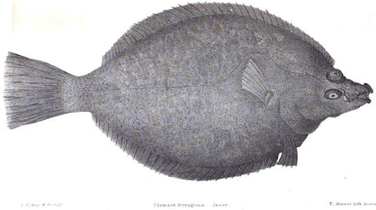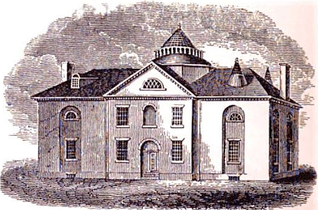Boston Society of Natural History

The Boston Society of Natural History (1830-1948) in Boston, Massachusetts, was an organization dedicated to the study and promotion of natural history. It published a scholarly journal and established a museum. In its first few decades, the society occupied several successive locations in Boston's Financial District, including Pearl Street, Tremont Street and Mason Street. In 1864 it moved into a newly constructed museum building in the Back Bay, designed by architect William Gibbons Preston. In 1951 the society evolved into the Museum of Science, and relocated to its current site on the Charles River.[1][2]
Brief history

Founders of the society in 1830 included Amos Binney Jr.; Edward Brooks; Walter Channing; Henry Codman; George B. Emerson; Joshua B. Flint; Benjamin D. Greene; Simon E. Greene; William Grigg; George Hayward; D. Humphreys Storer; and John Ware. Several had previously been involved with the Linnaean Society of New England. By 1838, the society held "regular meetings on the 2nd and 4th Wednesday of each month."[3] "In its collection are about 700 specimens in mineralogy and geology, besides the rich collection of Dr. C.T. Jackson, and the state collection; botany, 5,000; mammalia, 30 entire skeletons and 30 crania; birds, 200 species; reptiles, 130; insects, about 15,000; crustacea, 130; radiata, 190. Library, 600 volumes and pamphlets. The room ... gratuitously opened to the public every Wednesday from 12 to 2 o'clock."[3]
Among the many scholars and curators affiliated with the society: Alexander Emanuel Agassiz; T.T. Bouve; Thomas Mayo Brewer; George Emerson; A.A. Gould; F.W.P. Greenwood; Charles Thomas Jackson; Charles Sedgwick Minot; Albert Ordway; Samuel Hubbard Scudder; Charles J. Sprague; Alpheus Hyatt, and Jeffries Wyman.


"After World War II, under the leadership of Bradford Washburn, the society sold the Berkeley Street building, changed its name to the Boston Museum of Science. ... The cornerstone for the new Museum was laid at Science Park [in 1949] and a temporary building was erected to house the Museum's collections and staff. In 1951, the first wing of the new Museum officially opened."[4]
See also
- Boston Journal of Natural History, published by the society (1834-1863)
- Museum of Science (Boston)
References
- ↑ P. Creed, ed. The Boston Society of Natural History, 1830-1930. Boston: 1930.
- ↑ Richard I. Johnson. The Rise and Fall of the Boston Society of Natural History. Northeastern Naturalist, Vol. 11, No. 1 (2004), pp. 81-108.
- 1 2 Boston Almanac. 1838.
- ↑ Museum of Science, Boston. History of the Museum of Science. Retrieved 05-01-2010
Further reading
Publications of the society
- Act of incorporation, constitution, and by-laws of the Boston Society of Natural History. John H. Eastburn, printer, 1832.
- Boston Journal of Natural History. v.1 (1834-1837); v.2 (1838-1839); v.4 (1843-1844); v.5 (1845-1847); v.6 (1850-1857); v.7 (1859-1863).
- Proceedings of the Boston Society of Natural History. v.1 (1841-1844); v.34 (1907-1912)
- Memoirs Read Before the Boston Society of Natural History. (1861-1949). v.1 (1866-1869).
- Objects and claims of the Boston Society of Natural History. Printed by J. Wilson and Son, 1861.
- Annual report. (1865-1876)
- Alpheus Spring Packard. Observations on the glacial phenomena of Labrador and Maine. 1867.
- Louis Agassiz. Address delivered on the centennial anniversary of the birth of Alexander von Humboldt. 1869. (The lecture took place at Music Hall, followed by a reception at Horticultural Hall).
- Anniversary memoirs of the Boston Society of Natural History, 1830-1880. Boston, 1880.
- Lucien Carr. Notes on the crania of New England Indians. 1880.
- William James. The feeling of effort. 1880.
- Museum and Library bulletin. 1906.
- Douglas Wilson Johnson. A geological excursion in the Grand Cañon district. 1909.
- Bulletin of the Boston Society of Natural History. 1915.
- P. Creed, ed. The Boston Society of Natural History, 1830-1930. Boston: 1930.
About the society
- Boston Society of Natural History. Boston Daily Atlas, 05-31-1847.
- Boston Society of Natural History; Daily Atlas, 03-13-1850.
- Boston Society of Natural History. Boston Daily Globe, Mar 5, 1872. p. 8.
- Man's origin; Mr. F. W. Putnam's Lecture Last Night at the Miseum of the Boston Society of Natural History. Boston Daily Globe, Dec 27, 1876. p. 8.
- Boston Society of Natural History, 1830-1880. Nature, Feb. 23, 1882. p. 389.
- The Worcester Mastadone: the Boston Society of Natural History discusses it. New York Times, November 8, 1885.
- They won't bite; But the Big Animals in the Natural History Museum on the Back Bay Present a Pretty Ferocious Picture. Boston Daily Globe, Apr 21, 1895. p. 37
- Sea monstrosity sold at auction; Some Say the Specimen is a Real Serpent. Natural History Museum Bids in Stranger of the Deep. Boston Daily Globe, Jul 22, 1910. p. 9.
- Bronze moose for Roosevelt; C. Emerson Brown of Boston Society of Natural History Sends Him Statue. Boston Daily Globe, Sep 15, 1912. p. 11.
- New group of bears at the Natural History Museum; Mother and Cubs Mounted in a Setting That Was Brought From Maine Woods to Make Surroundings True to Nature. Boston Daily Globe, Dec 16, 1917. p. 14.
- K S Bartlett. All New England Museum now open; Boston Society of Natural History Rearranging and Completing Its Collections So That the Boylston-St Building Will Completely Show the Birds, Animals, Insects, Fishes and Minerals of the Six States. Boston Daily Globe, Feb 23, 1919. p. 34.
- Boasts of its great Auk; Only 10 Specimens in the Country of This Extinct Bird—Natural History Museum Has One Found by Owne Bryant on Lonely Funk Island. Boston Daily Globe. Jul 11, 1920. p. 66.
- Speaking of Pictures...Boston Museum Exhibits Candid Animal Pictures. Life Magazine, Feb 5, 1940.
- Kenneth Walter Cameron. Emerson, Thoreau, and the Society of Natural History. American Literature, Vol. 24, No. 1 (Mar., 1952), pp. 21–30
- Sally Gregory Kohlstedt, "The Nineteenth-Century Amateur Tradition: The Case of the Boston Society of Natural History," in Science and its Public: The Changing Relationship, ed. Herald Holton and William A. Blanpied (Dordrecht: D. Reidel, 1976), 173-190.
- Sally Gregory Kohlstedt, "From Learned Society to Public Museum: The Boston Society of Natural History," in The Organization of Knowledge in Modern America, 1860-1920, ed. Alexandra Oleson and John Voss (Baltimore: Johns Hopkins University Press, 1979), 386-406.
- Richard I. Johnson. The Rise and Fall of the Boston Society of Natural History. Northeastern Naturalist, Vol. 11, No. 1 (2004), pp. 81–108.
Images
1830-1833
 Amos Binney, founder
Amos Binney, founder George B. Emerson, founder
George B. Emerson, founder Benjamin D. Greene, founder
Benjamin D. Greene, founder Boston Athenaeum building, Pearl Street, Boston, home to the BSNH in the early 1830s
Boston Athenaeum building, Pearl Street, Boston, home to the BSNH in the early 1830s
1833-1863
 Building of the Provident Inst. for Savings, Tremont St., Boston, built in 1833. Offices on the third floor were occupied by the Boston Society of Natural History, 1833-1847
Building of the Provident Inst. for Savings, Tremont St., Boston, built in 1833. Offices on the third floor were occupied by the Boston Society of Natural History, 1833-1847 Plate from: Boston Journal of Natural History, 1837
Plate from: Boston Journal of Natural History, 1837 Plate from: Boston Journal of Natural History, v.2. 1839.
Plate from: Boston Journal of Natural History, v.2. 1839. Home of the Boston Society of Natural History (c. 1847-1863), Mason Street, Boston
Home of the Boston Society of Natural History (c. 1847-1863), Mason Street, Boston
1864-1946
 Natural History Museum, corner of Boylston Street and Berkeley Street, Back Bay, Boston, c. 1864
Natural History Museum, corner of Boylston Street and Berkeley Street, Back Bay, Boston, c. 1864 Museum exhibition gallery, c. 1930
Museum exhibition gallery, c. 1930 Museum interior, c. 1930
Museum interior, c. 1930- Former museum building, Newbury Street, Boston, 2009
External links
| Wikimedia Commons has media related to Boston Society of Natural History. |
- Boston Museum of Science
- Hancock Library, University of Southern California. Acquired the library of the Boston Society of Natural History in 1944-1946.
- "Whatever Happened to our Flamingo?". The Beehive (blog). Massachusetts Historical Society. 2010. (Describes items given to the Boston Society of Natural History in the 1830s)
